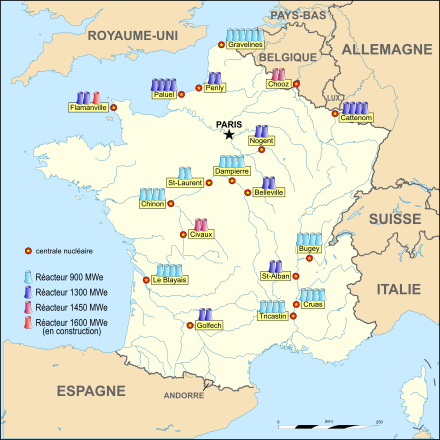Nuclear power station shut down in France: rather for political reasons or technical ones?
 |
| Map of French nuclear stations |
Here are the parameters of the situation:
The nuclear power station of Fessenheim (Eastern France) is the oldest one of the French nuclear park (the old lady will compute 40 years of production in 2017). As such, it was considered to be the first to be closed in the wake of a green energy transition period. Nevertheless, EDF, Électricité de France, the operating utility, gathered its board of Directors in order to take a decision about the station decommissioning on April 6th.
The final decision was to postpone the closure after the commissioning of Flamanville EPR nuclear station (in Normandy, West of France), in order to avoid to produce less than the 63,2 GW limit set in the 2015 energy transition law. Though technical delays, this commissioning is still scheduled for late 2018. Moreover, the decision gives EDF the possibility to choose to close either the Fessenheim station or another one.
Nevertheless, the Fessenheim closure is still a thorny issue in a blurred political electoral campaign, but also for economic reasons.
Why all this fuss and this open opposition between EDF and the French government?
First, the closure was an electoral promise of presidential candidate Hollande
As soon as he expressed his idea, a lot of counter-measures were launched at a missile speed, the first being the job impact on the local area: indeed 2,000 workers are directly or indirectly involved in the nuclear plant. So what? 2,000 jobseekers more in a context where the joblessness is still skyrocketing?
Second, still on the political ground. in 2015, the law on energy transition was adopted. This law stipulates that the nuclear part in the French energy mix should be reduced from 75% to 50%. That’s implying that several power stations should be closed. But it implies moreover that the possibility of growth of EDF shall be sharpened widely. That’s a perspective that no company would accept easily, for the simple reason that the obvious aim of everybody’s company is to expand and expand its revenues.
What are the economic consequences of the Fessenheim closure?
Beyond the 2,000 positions jeopardised by the closure, here are some financial figures which may need a thorough analysis.
Indeed the power station delivers some €400 million of Ebitda, depending on the power wholesale prices.
Then, what is not so much emphasized in the public media, a third of Fessenheim station production is allocated to minority shareholders, mainly from Germany and Switzerland: EnBW, Alpiq, Axpo and BKW (they account for 15% of the capital of the power station), to pay for their minority stakes in the capital.
So, these financial parameters entail a compensation to be paid to EDF in case of closure, as a kind of damage: some €490 million shall be paid when both reactors will be shut down (normally in 2019 and 2021), with an adjustment made depending on power market price, until 2041.
Fessenheim power station, what is it?
The power station is composed of two reactors of 900MW each.
The station is located in an area considered as presenting seismic exposure and exposure to floods.
The staff accounts for 750 workers but gives work to some 1,250 more among contractors and
regional local firms.
regional local firms.
EDF: a state company or an hybrid monster?
You already know the hybrid vehicles but you don’t know what is a hybrid monster in the field of companies and societies…
The negotiations around Fessenheim closure highlight several judicial, economic and regulatory points which may be difficult to understand abroad.
Even if the French State is EDF’s main shareholder (its stake amounts to 85% of the capital), the State was unable to compel the company to abide by the presidential promise to shut down Fessenheim station. This promise was only words. Why? Because a president can’t decide by himself to close this or that: only the operator (here: EDF) or the ASN (the French nuclear watchdog) can apply a request for closure, either for lack of profitability or for security reasons (in the ASN case). The request procedure is really long and difficult.
Moreover, as a stakeholder, the State has appointed six administrators in EDF board of Directors. But during the sessions, it’s forbidden for the State to vote when it is involved as a party in the negotiations. So its six administrators could not take part in the votes and decisions. Only the staff representing administrators and the independent ones remain able to vote, which make the final decisions really uncertain.
Then, when the president decided to reduce the part of nuclear generation in the energy mix from 75% to 25%, the law corresponding to this was amended several times, only to conclude that the part of the nuclear generation should not be above the present production, namely 63,2 GW, and EDF is interpreting this threshold not as a roof but as a bottom line.
Finally the implementation of an energy multi-year planning reportedly designed to pilot the State action in the energy field was not awarded to any ministry but to… EDF.
The Fessenheim case illustrates several dysfunctions: during five years, 2,000 jobs have been threatened by a possible closure. It’s simply non-economical.
Moreover during the discussions, the possible setting of a nuclear dismantling sector or the industrial future of the nuclear sites have never been considered.
From Véronique LeBillon and Anne Feitz, « Les Échos »




Aucun commentaire:
Enregistrer un commentaire